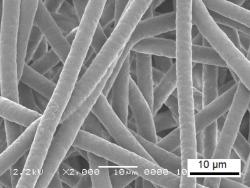Research Overview
The primary goal of the lab is overcoming the current limitations to engineering small-diameter vascular grafts, which include the lack of a functional endothelium and limited elastic matrix production. There is also a project involved manufacturing technologies and tissue vascularization. Other project are also being conducted, but all involve studying the cell-microenvironment interaction.
Scaffold materials that modulate the host response: 
- This includes the simple addition of natural materials such as collagen. This also includes the more unique carbon monoxide releasing materials (CORMs). When implanted into animals, these materials can modify the inflammatory response.
- These scaffolds can be processed in several different ways. We primarily use the technique of electrospinning, but a collaboration with Dr. Kishore is investigating a different way of generating aligned fibers.
Incorporation of photo-sensitive materials
- This is a collaboration with Dr. Liao in the Chemistry Department. These materials include the CORMs described above, as well as photoacids that can be used for cancer-treatment applications.
Detecting cell phenotype and mineralization with Raman Spectroscopy
- This is a collaboration with Dr. Fenn.
Collaborators:
- Dr. Yi Liao, Chemistry, Florida Institute of Technology
- Dr. James Brenner, Chemical Engineering, Florida Institute of Technology
- Dr. Michael Fenn, Biomedical Engineering, Florida Institute of Technology
- Dr. Vipuil Kishore, Chemical Engineering, Florida Institute of Technology

